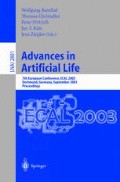Abstract
It is believed that the second phase of the Baldwin effect is basically governed by the cost of learning. In this paper we argue that when learning takes place the fitness landscape undergoes a modification that might block the Baldwin effect even if the cost of learning is high. The argument is that learning strategies will bias the evolutionary process towards individuals that genetically acquire better compared to individuals that genetically behave better. Once this process starts the probability of experiencing the Baldwin effect decreases dramatically, whatever the learning cost. A simulation with evolving learning individuals capable of communication is set to show this effect. The set of acquired behaviors (culture) competes with the instinctive one (genes) giving rise to a co-evolutionary effect.
Access this chapter
Tax calculation will be finalised at checkout
Purchases are for personal use only
Preview
Unable to display preview. Download preview PDF.
References
Baldwin, J.M.: A new factor in evolution. American Naturalist 30, 441–451 (1896)
Downing, K.: Reinforced Genetic Programming. In: Genetic Programming & Evolvable Machines, pp. 259–288. Kluwer Publishers, Dordrecht (2001)
Turney, P.: Myths and legends of the Baldwin Effect. In: Proceedings of the ICML-1996 (13th International Conference on Machine Learning) pp.135–142 (1996)
Turney, P., Whitley, D., Anderson, R.: Evolution, learning and instict: 100 years of the Baldwin effect. Evolutionary Computation 4(3), 206–212 (1996)
Belew, R.K., Mitchell, M.: Adaptive individuals in evolving populations: models and algorithms. Addison-wesley, Reading (1996)
Hinton, G.E., Nowlan, S.J.: How learning can guide evolution. Complex Systems 1, 495–502 (1987)
Chalupa, L.M., Finlay, B.L.: Development and organization of the retina: from molecules to function. Plenum Press, New York (1998)
French, R., Messinger, A.: Genes, phenes and the Baldwin effect. In: Proceedings of Artificial Life IV, pp. 277–282 (1994)
Dawkins, R.: The selfish gene. Oxford university press, Oxford (1976)
Kandel, E.R., Schwartz, J.S., Jessell, T.M.: Principles of neural science, 4th edn. Elsevier Science Publishing Co., New York (2000)
Markram, H., L’bke, J., Frotscher, M., Sakmann, B.: Regulation of Synaptic Efficacy by Coincidence of Post-synaptic APs and EPSPs. Science 275, 213–215 (1997)
Carew, T.J.: Behavioral Neurobiology: The Cellular Organization of Natural Behavior Sinauer Associates (2000)
Arita, T., Suzuki, R.: Interactions between learning and evolution: The outstanding strategy generated by the Baldwin effect. In: Proceedings of Artificial Life VII, pp. 196–205 (2000)
Author information
Authors and Affiliations
Editor information
Editors and Affiliations
Rights and permissions
Copyright information
© 2003 Springer-Verlag Berlin Heidelberg
About this paper
Cite this paper
Federici, D. (2003). Culture and the Baldwin Effect. In: Banzhaf, W., Ziegler, J., Christaller, T., Dittrich, P., Kim, J.T. (eds) Advances in Artificial Life. ECAL 2003. Lecture Notes in Computer Science(), vol 2801. Springer, Berlin, Heidelberg. https://doi.org/10.1007/978-3-540-39432-7_33
Download citation
DOI: https://doi.org/10.1007/978-3-540-39432-7_33
Publisher Name: Springer, Berlin, Heidelberg
Print ISBN: 978-3-540-20057-4
Online ISBN: 978-3-540-39432-7
eBook Packages: Springer Book Archive

